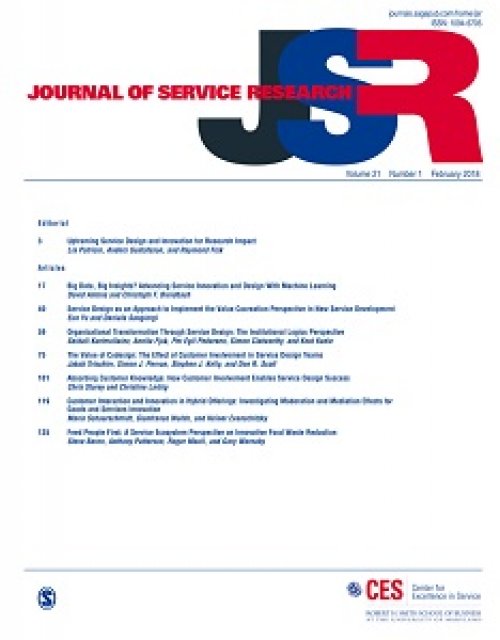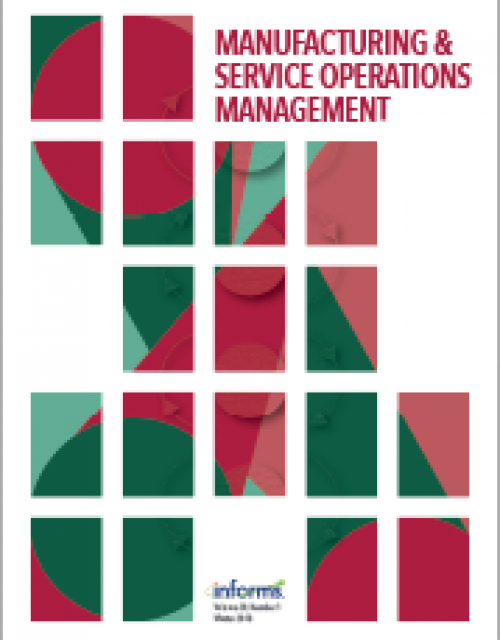Publication records
Subject(s)
Human resources management/organizational behavior
Keyword(s)
negotiation, first offer, impasses, anchoring, machine learning, big data
Volume
120
Journal Pages
e2218582120
Subject(s)
Diversity and inclusion; Health and environment; Management sciences, decision sciences and quantitative methods; Product and operations management
Keyword(s)
shared medical appointments, patient compliance, patient satisfaction, innovation in healthcare delivery, global public health, healthcare operations
In Shared Medical Appointments (SMAs), patients with similar conditions meet the physician together and each receives one-on-one attention. SMAs can improve outcomes and physician productivity. Yet privacy concerns have stymied adoption. In physician-deprived nations, patients’ utility from improved access may outweigh their disutility from loss of privacy. Ours is to our knowledge the first SMA trial for any disease, in India, where doctors are scarce. In a 1,000-patient, single-site, randomized controlled trial at Aravind Eye Hospital, Pondicherry, we compared SMAs and one-on-one appointments, over four successive visits, for patients with glaucoma. We examined patients’ satisfaction, knowledge, intention-to-follow-up, follow-up rates, and medication compliance rates (primary outcomes) using intention-to-treat analysis. Of 1,034 patients invited between July 12, 2016 – July 19, 2018, 1,000 (96.7%) consented to participate, and were randomly assigned to either SMAs (NSMA=500) or one-on-one appointments (N1-1=500). Patients who received SMAs showed higher satisfaction (MeanSMA=4.955 (SD 0.241), Mean1-1=4.920 (SD 0.326); difference in means 0.035; 95% CI, 0.017-0.054, p=0.0002) and knowledge (MeanSMA=3.416 (SD 1.340), Mean1-1=3.267 (SD 1.492); difference in means 0.149; 95% CI, 0.057–0.241, p=0.002) than patients who received one-on-one appointments. Across conditions, there was no difference in patients’ intention-to-follow-up (MeanSMA=4.989 (SD 0.118), Mean1-1=4.986 (SD 0.149); difference in means 0.003; 95% CI, -0.006–0.012, p=0.481) and actual follow-up rates (MeanSMA=87.5% (SD 0.372), Mean1-1=88.7% (SD 0.338); difference in means -0.012; 95% CI, -0.039–0.015, p=0.377). Patients who received SMAs exhibited higher medication compliance rates (MeanSMA=97.0% (SD 0.180), Mean1-1=94.9% (SD 0.238); difference in means 0.020; 95% CI, 0.004–0.036, p=0.013). SMAs improved satisfaction, learning, and medication compliance, without compromising follow-up rates or measured clinical outcomes. Peer interruptions were negatively correlated with patient satisfaction in early-trial SMAs and positively correlated with patient satisfaction in later-trial SMAs. The trial was registered with Clinical Trials Registry of India with reference no. REF/2016/11/012659 and registration no. CTRI/2018/02/011998.
©2023 Sönmez et al.
Volume
3
Journal Pages
e0001648
ISSN (Online)
2767-3375
Subject(s)
Marketing
Keyword(s)
price negotiation, power, dependency, buyer–seller relationship, demand contraction
Extant literature has studied how customer–salesperson price negotiations evolve in “normal” circumstances. However, recent economic recessions illustrate the need to advance theory on the question of how price negotiations evolve in “abnormal” times when customer demand significantly contracts beyond expected variation. In response to this gap in the literature, this study uses a multi-method design to investigate price negotiations during exceptional demand contractions. Our results from a theories-in-use study reveal that during such circumstances, salespeople’s perceived dependency on customers increases while customers’ perceived dependency on salespeople decreases. The inherent “power shift” should benefit customers in subsequent price negotiations. However, customers are less likely to capitalize on their power if they have a close relationship with a salesperson, implying that salespeople do not have to concede on price negotiations. This effect is likely due to increased sympathy during periods of exceptional demand contractions. The authors further validate key propositions from this qualitative study in a field study and a scenario-based experiment. Altogether, this study suggests that managers should not be too hasty in approving and encouraging salespeople to offer unnecessary price discounts during exceptional demand contractions as buyers may become more sympathetic and lenient during price negotiations.
With permission of SAGE Publishing
Volume
26
Journal Pages
351–370
Subject(s)
Management sciences, decision sciences and quantitative methods
Keyword(s)
congestion, diagnostic accuracy, experiments, partially observable markov decision process, path-dependent decision making, undertesting, task completion bias
To study the effect of congestion on the fundamental trade-off between diagnostic accuracy and speed, we empirically test the predictions of a formal sequential testing model in a setting where the gathering of additional information can improve diagnostic accuracy, but may also take time and increase congestion as a result. The efficient management of such systems requires a careful balance of congestion-sensitive stopping rules. These include diagnoses made based on very little or no diagnostic information, and the stopping of diagnostic processes while waiting for information. We test these rules under controlled laboratory conditions, and link the observed biases to system dynamics and performance. Our data shows that decision makers (DMs) stop diagnostic processes too quickly at low congestion levels where information acquisition is relatively cheap. But they fail to stop quickly enough when increasing congestion requires the DM to diagnose without testing, or diagnose while waiting for test results. Essentially, DMs are insufficiently sensitive to congestion. As a result of these behavioral patterns, DMs manage the system with both lower-than-optimal diagnostic accuracy and higher-than-optimal congestion cost, underperforming on both sides of the accuracy/speed trade-off.
© 2023, INFORMS
Volume
71
Journal Pages
791–1020
Subject(s)
Economics, politics and business environment
Keyword(s)
Credit card demand reactions to fees, late fee regulation, limited attention
JEL Code(s)
D12, D90, G50
We introduce a model of a rational credit card user's rather complex usage choices and develop an empirical framework to test its predictions. Employing a large national database of U.S. card accounts, we estimate how prices impact card usage and find that price effects are mostly well explained within our model. An exception is less borrowing in response to declining late-fees among low credit-score (subprime) users. Extension of our model based on "focusing theory" predicts this behavior. It also implies substantial indirect benefits of the CARD Act's late-fee cap due to subprime users re-focusing toward reducing their debt.
Volume
63
Journal Pages
273–311
Subject(s)
Economics, politics and business environment; Ethics and social responsibility; Finance, accounting and corporate governance
Keyword(s)
green finance; ESG goals; climate policy
Volume
74
Journal Pages
1–19
ISSN (Online)
2366-035X
Subject(s)
Economics, politics and business environment
Keyword(s)
internal labor markets, organization of labor, wage setting
JEL Code(s)
J31, J62, M5
This paper develops a new method to study how workers’ career and wage profiles are shaped by internal labor markets (ILM) and job hierarchies in firms. We tackle the conceptual challenge of organizing jobs within firms into hierarchy levels by proposing a data-driven ranking method based on observed worker flows between occupations within firms. We apply our method to linked employer–employee data from Norway that record fine-grained occupational codes and track contract changes within firms. Our findings confirm existing evidence that is primarily based on case studies for single firms. We expand on this by documenting substantial heterogeneity in the structure and hierarchy of ILMs across a broad range of large firms. Our findings on wage and promotion dynamics in ILMs are consistent with models of careers in organizations.
Volume
233
Journal Pages
661–688
Subject(s)
Economics, politics and business environment; Strategy and general management; Technology, R&D management
Keyword(s)
bundling, tying, competition, innovation, cloud computing
JEL Code(s)
K21, L12, L41
Pages
6
Journal Pages
211–216
Subject(s)
Management sciences, decision sciences and quantitative methods
Keyword(s)
Service operations, rational inattention, strategic customers, rational queueing, information costs, system throughput, social welfare
Problem description: Classical models of queueing systems with rational and strategic customers assume queues to be either fully visible or invisible while service parameters are known with certainty. In practice, however, people only have “partial information” on the service environment in the sense that they are not able to fully discern prevalent uncertainties. This is because assessing possible delays and rewards is costly as it requires time, attention, and cognitive capacity which are all limited. On the other hand, people are also adaptive and endogenously respond to information frictions. Methodology: We develop an equilibrium model for a single-server queueing system with customers having limited attention. Following the theory of rational inattention, we assume that customers optimize their learning strategies by deciding the type and amount of information to acquire and act accordingly while internalizing the associated costs. Results: We establish the existence and uniqueness of a customer equilibrium and delineate the impact of service characteristics and information costs. We numerically show that when customers allocate their attention to learn uncertain queue length, limited attention of customers improves throughput in a congested system that customers value reasonably highly, while it can be detrimental for less popular services that customers deem rather unrewarding. This is also reflected in social welfare if the firm's profit margin is high enough, although customer welfare always suffers from information costs. Managerial implications: Our results shed light on optimal information provision and physical design strategies of service firms and social planners by identifying service settings where they should be most cautious for customers' limited attention. Academic/practical relevance: We propose a microfounded framework for strategic customer behavior in queues that links beliefs, rewards, and information costs. It offers a holistic perspective on the impact of information prevalence (and information frictions) on operational performance and can be extended to analyze richer customer behavior and complex queue structures, rendering it a valuable tool for service design.
© 2021 INFORMS
Volume
25
Journal Pages
266–287
Subject(s)
Economics, politics and business environment; Information technology and systems
Keyword(s)
digital government, cyber risk, cyber crisis management, network governance, resilience, electronic identity, estonia
Volume
40
Journal Pages
101781

